|

This image of the debris of an exploded star -- known as supernova remnant 1E 0102.2-7219, or "E0102" for short -- features data from NASA's Chandra X-ray Observatory. E0102 is located about 190,000 light years away in the Small Magellanic Cloud, one of the nearest galaxies to the Milky Way. It was created when a star that was much more massive than the Sun exploded, an event that would have been visible from the Southern Hemisphere of the Earth over 1000 years ago.
Chandra first observed E0102 shortly after its launch in 1999. New X- ray data have now been used to create this spectacular image and help celebrate the ten-year anniversary of Chandra's launch on July 23, 1999. In this latest image of E0102, the lowest-energy X-rays are colored orange, the intermediate range of X-rays is cyan, and the highest-energy X-rays Chandra detected are blue. An optical image from the Hubble Space Telescope (in red, green and blue) shows additional structure in the remnant and also reveals foreground stars in the field.
The Chandra image shows the outer blast wave produced by the supernova (blue), and an inner ring of cooler (redder) material. This inner ring is probably expanding ejecta from the explosion that is being heated by a shock wave traveling backwards into the ejecta. A massive star (not visible in this image) is illuminating the green cloud of gas and dust to the lower right of the image. This star may have similar properties to the one that exploded to form E0102.
Analysis of the Chandra spectrum gives astronomers new information about the geometry of the remnant, with implications for the nature of the explosion. The spectrum -- which precisely separates X-rays of different energies -- shows some material is moving away from Earth and some is moving toward us. When the material is moving away, its light is shifted toward the red end of the spectrum due to the so-called Doppler effect. Alternatively, when material is moving toward us, the light is bluer because of the same effect.
A clear separation was detected between the red-shifted and blue- shifted light, leading astronomers to think that the appearance of E0102 is best explained by a model in which the ejecta is shaped like a cylinder that is being viewed almost exactly end-on (see animation). The smaller red and blue cylinders represent faster moving material closer to the cylinder axis.

NASA's Spitzer Space Telescope has captured a new, infrared view of the choppy star-making cloud called M17, or the Swan nebula.
The cloud, located about 6,000 light-years away in the constellation Sagittarius, is dominated by a central group of massive stars -- the most massive stars in the region. These central stars give off intense flows of expanding gas, which rush like rivers against dense piles of material, carving out the deep pocket at center of the picture. Winds from the region's other massive stars push back against these oncoming rivers, creating bow shocks like those that pile up in front of speeding boats.
Three of these bow shocks are nestled in the upper left side of the central cavity, but are difficult to spot in this view. They are composed of compressed gas in addition to dust that glows at infrared wavelengths Spitzer can see. The smiley-shaped bow shocks curve away from the stellar winds of the central massive stars.
This picture was taken with Spitzer's infrared array camera. It is a four-color composite, in which light with a wavelength of 3.6 microns is blue; 4.5-micron light is green; 5.8-micron light is orange; and 8-micron light is red. Dust is red, hot gas is green and white is where gas and dust intermingle. Foreground and background stars appear scattered through the image.
Image credit: NASA/JPL-Caltech/Univ. of Wisc.

This infrared image from NASA's Spitzer Space Telescope shows three baby stars in the bustling center of our Milky Way galaxy. The three stars are the first to be discovered in the region -- previous attempts to find them were unsuccessful because there is so much dust standing between us and our galaxy's core. Spitzer was able to find the newborns with its sharp infrared eyes, which can cut through dust.
The center of our galaxy is a hectic place. It's stuffed with stars, gas and dust. Astronomers have long wondered how stars can form in such chaotic circumstances. While they have known that stars are born there, they weren't able to see the stars forming until now. Astronomers plan to search for more newborn stars in the region, and ultimately learn more about stellar births at the center of the Milky Way.
Image credit: NASA/JPL-Caltech

Three-colour composite mosaic image of the Eagle Nebula (Messier 16, or NGC 6611), based on images obtained with the Wide-Field Imager camera on the MPG/ESO 2.2-metre telescope at the La Silla Observatory. At the centre, the so-called �Pillars of Creation� can be seen. This wide-field image shows not only the central pillars, but also several others in the same star-forming region, as well as a huge number of stars in front of, in, or behind the Eagle Nebula. The cluster of bright stars to the upper right is NGC 6611, home to the massive and hot stars that illuminate the pillars. The �Spire� � another large pillar � is in the middle left of the image.

New portrait of Omega Nebula's glistening watercolours
The Omega Nebula, a stellar nursery where infant stars illuminate and sculpt a vast pastel fantasy of dust and gas, is revealed in all its glory by a new ESO image.
The Omega Nebula, sometimes called the Swan Nebula, is a dazzling stellar nursery located about 5500 light-years away towards the constellation of Sagittarius (the Archer). An active star-forming region of gas and dust about 15 light-years across, the nebula has recently spawned a cluster of massive, hot stars. The intense light and strong winds from these hulking infants have carved remarkable filigree structures in the gas and dust.
When seen through a small telescope the nebula has a shape that reminds some observers of the final letter of the Greek alphabet, omega, while others see a swan with its distinctive long, curved neck. Yet other nicknames for this evocative cosmic landmark include the Horseshoe and the Lobster Nebula.
Swiss astronomer Jean-Philippe Loys de Ch�seaux discovered the nebula around 1745. The French comet hunter Charles Messier independently rediscovered it about twenty years later and included it as number 17 in his famous catalogue. In a small telescope, the Omega Nebula appears as an enigmatic ghostly bar of light set against the star fields of the Milky Way. Early observers were unsure whether this curiosity was really a cloud of gas or a remote cluster of stars too faint to be resolved. In 1866, William Huggins settled the debate when he confirmed the Omega Nebula to be a cloud of glowing gas, through the use of a new instrument, the astronomical spectrograph.
In recent years, astronomers have discovered that the Omega Nebula is one of the youngest and most massive star-forming regions in the Milky Way. Active star-birth started a few million years ago and continues through today. The brightly shining gas shown in this picture is just a blister erupting from the side of a much larger dark cloud of molecular gas. The dust that is so prominent in this picture comes from the remains of massive hot stars that have ended their brief lives and ejected material back into space, as well as the cosmic detritus from which future suns form.

IT LOOKS like a soap bubble or perhaps even a camera fault, but the image at right is a newly discovered planetary nebula.
Planetary nebulae, which got their name after being misidentified by early astronomers, are formed when an ageing star weighing up to eight times the mass of the sun ejects its outer layers as clouds of luminous gas (see Why stars go out in a blaze of glory). Most are elliptical, double-lobed or cigar-shaped, evolving after stars eject gas from each pole (see a gallery of the nebulae).
Dave Jurasevich of the Mount Wilson Observatory in California spotted the "Cygnus Bubble" while recording images of the region on 6 July 2008. A few days later, amateur astronomers Mel Helm and Keith Quattrocchi also found it.
The bubble, which was officially named PN G75.5+1.7 last week, has been there a while. A closer look at images from the second Palomar Sky Survey revealed it had the same size and brightness 16 years ago. Jurasevich thinks it was overlooked because it is very faint.
http://www.newscientist.com/gallery/dn16822-planetary-nebulae

The blinking nebula
This nebula is so faint in small telescopes that it appears to blink in and out of visibility. No one knows what has caused the red "fliers" on either side of the nebula.
Distance: 2200 light years
Size: 1.5 light years
(Image: Bruce Balick (University of Washington), Jason Alexander (University of Washington), Arsen Hajian (U. S. Naval Observatory), Yervant Terzian (Cornell University), Mario Perinotto (University of Florence, Italy), Patrizio Patriarchi (Arcetri Observatory, Italy) and NASA)

The eskimo nebula
A ring of gaseous "spokes" surrounds two elliptical bubbles of gas, one rising towards us, the other obscured behind, in this planetary nebula.
Distance: 5000 light years
Size: 2 light years
(Image: NASA/Andrew Fruchter/ERO Team/Sylvia Baggett/STScI/Richard Hook/ST-ECF/Zoltan Levay)

Hourglass nebula
What at first appear to be loops are actually hourglass shapes of gas, with the top lobe tilted towards us.
Distance: 8000 light years
Size: 0.3 light years
(Image: R. Sahai and J. Trauger(JPL), the WFPC2 Science Team and NASA)

Rotten egg nebula
Astronomers have detected large quantities of sulphur in this planetary nebula. The gas hydrogen sulphide is responsible for the smell of rotten eggs; hence the nebula's nickname.
Distance: 5000 light years
Size: 1.4 light years
(Image: NASA and The Hubble Heritage Team (STScI/AURA))

This image from NASA's Kepler mission shows the telescope's full field of view -- an expansive star-rich patch of sky in the constellations Cygnus and Lyra stretching across 100 square degrees, or the equivalent of two side-by-side dips of the Big Dipper.
A cluster of stars, called NGC 6791, and a star with a known planet, called TrES-2, are outlined. The cluster is eight billion years old, and located 13,000 light-years from Earth. It is called an open cluster because its stars are loosely bound and have started to spread out. TrES-2 is a hot Jupiter-like planet known to cross in front of, or transit, its star every 2.5 days. Kepler will hunt for transiting planets that are as small as Earth.
Image credit: NASA/Ames/JPL-Caltech
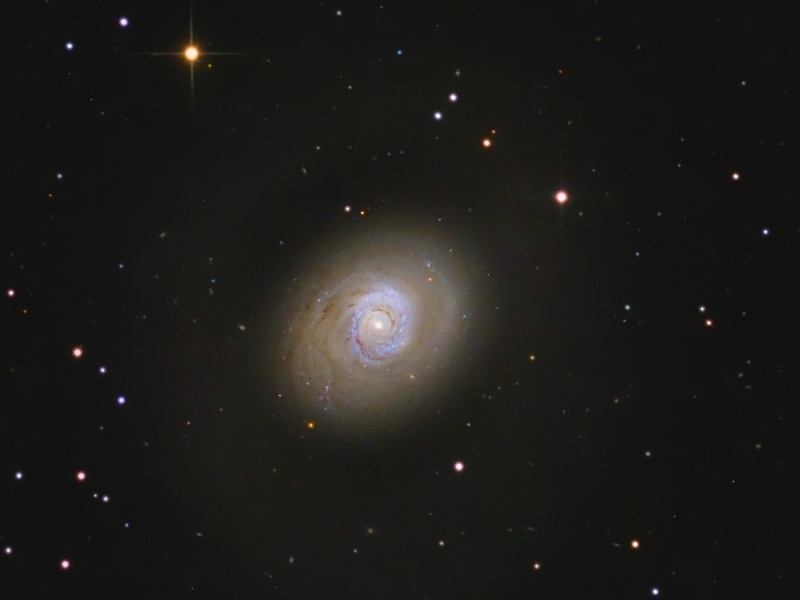
Starburst Galaxy M94
Credit & Copyright: Marcin Paciorek
Explanation: Beautiful island universe M94 lies a mere 15 million light-years distant in the northern constellation of the hunting dogs, Canes Venatici. A popular target for earth-based astronomers, the face-on spiral galaxy is about 30,000 light-years across. Its remarkable features include prominent dust lanes, a bright, point-like nucleus, and a bright, bluish ring dominated by the light of young, massive stars. The massive stars in the ring are all likely less than 10 million years old, indicating the galaxy experienced a well-defined era of rapid star formation. As a result, while the small, bright nucleus is typical of the Seyfert class of active galaxies, M94 is also known as a starburst galaxy. Because M94 is relatively nearby, astronomers can explore in detail reasons for the galaxy's burst of star formation.
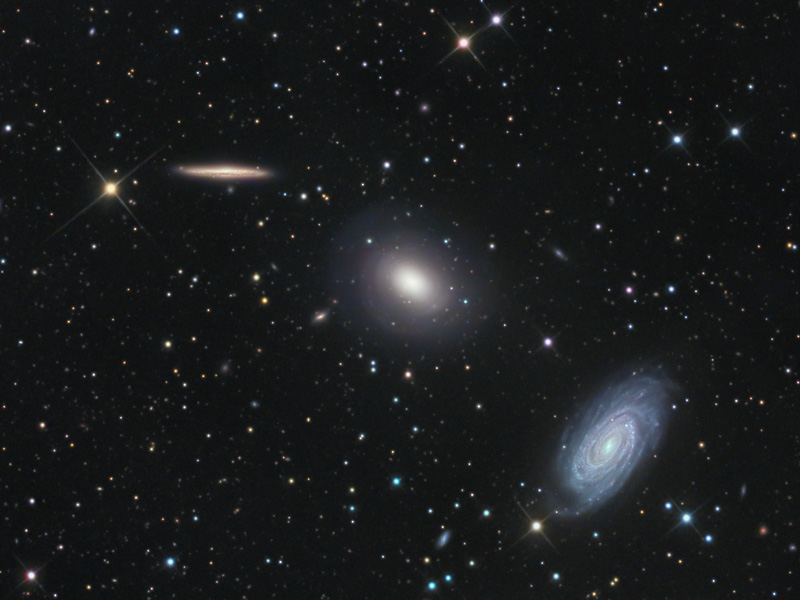
Three Galaxies in Draco
Credit & Copyright: Giovanni Benintende
Explanation: This intriguing trio of galaxies is sometimes called the Draco Group, located in the northern constellation of (you guessed it) Draco. From left to right are edge-on spiral NGC 5981, elliptical galaxy NGC 5982, and face-on spiral NGC 5985 -- all within this single telescopic field of view spanning a little more than half the width of the full moon. While the group is far too small to be a galaxy cluster and has not been cataloged compact group, these galaxies all do lie roughly 100 million light-years from planet Earth. On close examination with spectrographs, the bright core of the striking face-on spiral NGC 5985 shows prominent emission in specific wavelengths of light, prompting astronomers to classify it as a Seyfert, a type of active galaxy. Not as well known as other tight groupings of galaxies, the contrast in visual appearance makes this triplet an attractive subject for astrophotographers. This impressively deep exposure of the region also reveals faint and even more distant background galaxies.

Galaxy Zoo Hunters Help Astronomers Discover Rare 'Green Pea' Galaxies
ScienceDaily (July 28, 2009) � A team of astronomers has discovered a group of rare galaxies called the "Green Peas" with the help of citizen scientists working through an online project called Galaxy Zoo. The finding could lend unique insights into how galaxies form stars in the early universe.
The Galaxy Zoo users, who volunteer their spare time to help classify galaxies in an online image bank, came across a number of objects that stuck out because of their small size and bright green color. They dubbed them the Green Peas.
Employing the help of the volunteers to further analyze these strange new objects, the astronomers discovered that the Green Peas are small, compact galaxies forming stars at an incredibly high rate.
"These are among the most extremely active star-forming galaxies we've ever found," said Carolin Cardamone, an astronomy graduate student at Yale and lead author of the paper, to be published in an upcoming issue of the Monthly Notices of the Royal Astronomical Society.
Saturn

Never-before-seen looming vertical structures created by the tiny moon Daphnis cast long shadows across the rings in this startling image taken as Saturn approaches its mid-August 2009 equinox.
Daphnis, 8 kilometers ( 5 miles) across, occupies an inclined orbit within the 42-kilometer (26-mile) wide Keeler Gap in Saturn's outer A ring. Recent analyses by imaging scientists published in the Astronomical Journal illustrate how the moon's gravitational pull perturbs the orbits of the particles forming the gap's edge and sculpts the edge into waves having both horizontal and vertical components.
Measurements of the shadows in this and other images indicate that the vertical structures range between one-half to 1.5 kilometers tall (about one-third to one mile), making them as much as 150 times as high as the ring is thick. The main A, B and C rings are only about 10 meters (about 30 feet) thick. Daphnis itself can be seen casting a shadow onto the nearby ring.

Part of the shadow of Saturn's moon Mimas appears as if it has been woven through the planet's rings in this unusual series of images from Cassini. Together, the sequence of frames comprise an unusual demonstration of the varying particle density across the rings.
In these images, which were combined to create both a mosaic and a movie, the Cassini spacecraft looks toward the unilluminated side of the rings from about 61 degrees above the ringplane. Mimas' shadow, seen in multiple locations simultaneously in the mosaic, lies across the inner B ring, C ring and even the very faint D ring. The inner B ring is in the top left, and the C ring is in the middle of the image. The transparent D ring is faintly visible in the dark area in the lower right. Mimas is not shown.
The densest parts of the B and C rings, seen as bright stripes across Mimas' shadow, do not let much sunlight pass through to the spacecraft's camera. Consequently, one might expect these dense areas to appear dark because they are on the dark side of the rings. But these areas, particularly the inner B ring in the upper left of the image, appear brightly lit, even where Mimas' shadow crosses them. It is likely that illumination from Saturn itself and the subsequent reflection to the cameras keeps them relatively bright. As a result, the moon's shadow appears cut off and diminished in these areas.
Nineteen images, each taken about 2 minutes and 24 seconds apart, were combined to create this mosaic and movie. Contiguous images were stitched together to create a mosaic showing the whole swath of the rings across which the moon's shadow passed. One image is missing from the sequence, creating a gap in the movie.
http://www.nasa.gov/mov/361245main_pia11660.mov

This infrared image of Saturn's moon Titan shows a large burst of clouds in the moon's south polar region. These clouds form and move much like those on Earth, but in a much slower, more lingering fashion, new results from NASA's Cassini Spacecraft show.
This image is a color composite, with red shown at a 5-micron wavelength, green at 2.7 microns, and blue at 2 microns. An infrared color mosaic is also used as a background image (red at 5 microns, green at 2 microns, blue at 1.3 microns). The images were taken by Cassini's visual and infrared mapping spectrometer during a flyby of Titan on March 26, 2007, known as T27. For a similar view see PIA12004.
Titan's southern hemisphere still shows a very active meteorology (the cloud appears in white-reddish tones) even in 2007. According to climate models, these clouds should have faded out since 2005.
Mars
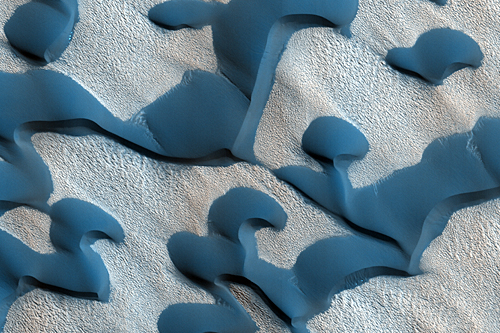
Polar Sand Dunes (PSP_009324_2650)
Credit: NASA/JPL/University of Arizona

Dune Field in Noachis Terra (ESP_013348_1185)
Credit: NASA/JPL/University of Arizona
This dune field is on the floor of a small crater in Noachis Terra located in the southern hemisphere of Mars.
The slip faces of the dunes have multiple directions, indicating that there were several wind directions and changes in wind strength when the dunes formed. The dominant dune type are transverse dunes (oriented perpendicular to the prevailing wind direction), with modified barchans (crescent-shaped dunes) in the northern region of the field and incipient linear dunes in the southern region.
The bright material scattered throughout the dune troughs, as well as at the bottom of the image, are outcrops of underlying bedrock.
The bottom of the image clearly displays a mass of dark dust devil tracks. Dust devils are wind funnels that suck up dust as they travel over the surface exposing the dark sandy substrate.
Written by: Kelly Kolb & Circe Verba
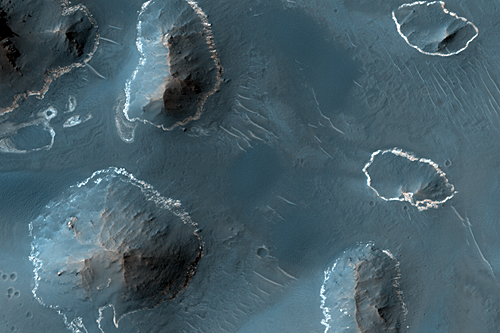
Light-Toned Rock Exposures in Noctis Labyrinthus (PSP_010397_1725)
Credit: NASA/JPL/University of Arizona
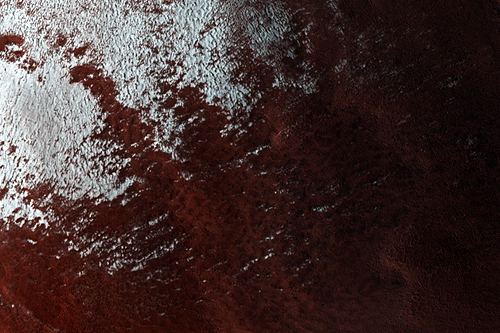
Sample of Northern Terrain (PSP_010345_2510)
Credit: NASA/JPL/University of Arizona

Dune Ribbons in Abalos Mensa (PSP_010369_2625)
Credit: NASA/JPL/University of Arizona
Venus

Mysterious bright spot found on Venus
23:52 29 July 2009 by Rachel Courtland
A strange spot emerged on Venus last week, and astronomers are not sure what caused it. They hope future observations will reveal whether volcanic activity, turbulence in the planet's atmosphere, or charged particles from the sun are to blame.
Amateur astronomer Frank Melillo of Holtsville, New York, first spotted the new feature, which is brighter than its surroundings at ultraviolet wavelengths, on the planet's southern hemisphere on 19 July. That same day, an amateur observer in Australia found a dark spot on Jupiter that had been caused by a meteoroid impact.
The Venus spot was confirmed by other observers, and images from Europe's Venus Express, the only spacecraft in orbit around the planet, later revealed that the spot had appeared at least four days before Melillo saw it.
Observations show that the spot had already spread out somewhat by the end of last week, and astronomers are awaiting more recent observations from Venus Express.
Moon

B�rg is a 40-km (about 25 miles) diameter, Copernican-aged, complex crater located within Lacus Mortis (the Lake of Death) on the near side of the moon. Complex craters, like this one, have terraced walls and a central peak (not shown here). The rim of the crater is along the right side and the walls slope down towards the left of the image. The terrace is about 3.5 km (about 2.2 miles) wide and is pockmarked with smaller craters. Terraces form as sections of the crater wall slump downward after the impact (image width: about 7.9 km across, roughly 4.9 miles). Note that there are very few impact craters on the wall of the crater. Usually fewer craters indicate a surface is younger, however in this case it's simply that material slides down the crater wall's steep slopes, erasing craters.
Note that LROC, LRO's camera, is powerful enough to see a shadow cast by a boulder about 8 meters wide (about 26 feet) at the contact between the wall and the terrace near the top of the figure.
LROC is capturing high-resolution images of the walls and floors of impact craters on the Moon. These images will provide detailed information on the processes that form complex craters.
Earth

A giant, anvil-shaped cloud bubbles up towards the Earth's stratosphere, looming over West Africa.
The amazing formation would be invisible to anyone on the ground and would even be obscure from a regular passenger jet since they can reach up to 75,000ft.
But astronauts captured the astonishing picture from hundreds of miles up as they orbited the globe on the International Space Station.
Anvil clouds are formed mostly from ice and normally form in the upper parts of thunderstorms. They get their shape from the fact that rising warm air in thunderstorms expands and spreads out as the air bumps up against the bottom of the stratosphere.
Streaks of snow are often seen falling out of the edges of anvils. This light snow usually evaporates as it falls through the relatively dry air surrounding the upper part of the thunderstorm.
Read more: http://www.dailymail.co.uk/sciencetech/article-1202973/Pictured-Spaceship-shaped-cloud-hovering-Earth-captured-astronauts.html#ixzz0MmpG74Po
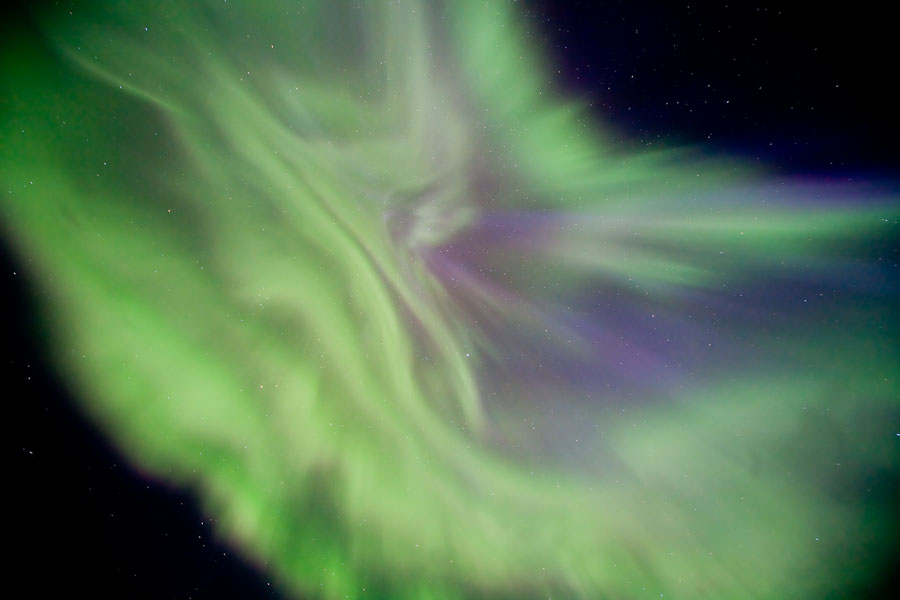
A Floral Aurora Corona
Credit & Copyright: Zoltan Kenwell (Infocus Imagery)
Explanation: Few auroras show this level of detail. Above, a standard digital camera captured a particularly active and colorful auroral corona that occurred last week above Alberta, Canada. With a shape reminiscent of a flower, the spectacular aurora had an unusually high degree of detail. The vivid green and purple auroral colors are caused by high atmospheric oxygen and hydrogen reacting to a burst of incoming electrons. Many photogenic auroras have been triggered from a solar wind stream that recently passed the Earth. The auroras were unexpected because the initiating Sun has been unusually quiet of late.

6 Minutes 42 Seconds
Credit & Copyright: Babak Tafreshi (TWAN)
Explanation: The July 22nd total solar eclipse was the longest of the 21st century. From the point of maximum eclipse along the Moon's shadow track across the Pacific Ocean, the Moon completely blocked the Sun for a total of 6 minutes and 39 seconds. But from the deck of this cruise ship the duration of the total eclipse phase was extended to a whopping 6 minutes and 42 seconds by the ship's motion along the shadow track. This panoramic view of the scene shows the shimmering solar corona in a darkened daytime sky, with clouds silhouetted by a bright sky on the distant horizon, beyond the Moon's shadow.

The Big Corona
Credit & Copyright: Koen van Gorp
Explanation: Most photographs don't adequately portray the magnificence of the Sun's corona. Seeing the corona first-hand during a total solar eclipse is best. The human eye can adapt to see features and extent that photographic film usually cannot. Welcome, however, to the digital age. The above picture is a combination of thirty-three photographs that were digitally processed to highlight faint features of a total eclipse that occurred in March of 2006. The images of the Sun's corona were digitally altered to enhance dim, outlying waves and filaments. Shadow seekers need not fret, though, since as yet there is no way that digital image processing can mimic the fun involved in experiencing a total solar eclipse. Last week, a spectacular total solar eclipse occurred over southern Asia, while the The next total solar eclipse will be visible from the South Pacific on 2010 July 11.
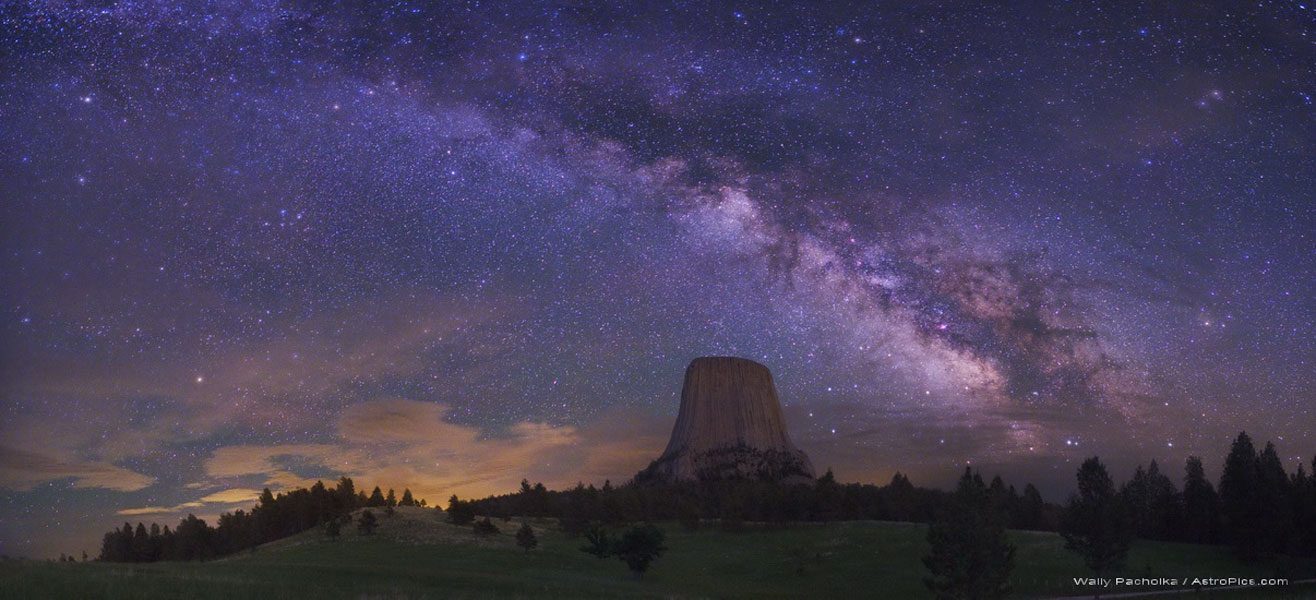
The Milky Way Over Devils Tower
Credit & Copyright: Wally Pacholka (TWAN)
Explanation: Was Devils Tower once an explosive volcano? Famous for its appearance in films such as Close Encounters, the origin of Devil's Tower in Wyoming, USA is still debated, with a leading hypothesis holding that it is a hardened lava plume that probably never reached the surface to become a volcano. The lighter rock that once surrounded the dense volcanic neck has now eroded away, leaving the dramatic tower. High above, the central band of the Milky Way galaxy arches across the sky. Many notable sky objects are visible, including dark strands of the Pipe Nebula and the reddish Lagoon Nebula to the tower's right. Green grass and trees line the moonlit foreground, while clouds appear near the horizon to the tower's left. Unlike many other international landmarks, mountaineers are permitted to climb Devils Tower.
|